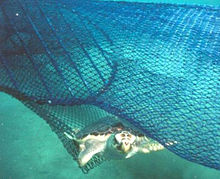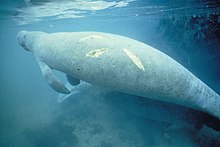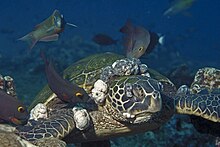Threats to sea turtles

Threats to sea turtles are numerous and have caused many
Artificial lighting
Artificial lighting is a threat to adult and hatchling sea turtles. Sea turtles use the brightest horizon as a guide to the ocean. This was created by celestial lights reflecting off the ocean’s surface. With human development along the coast, artificial light sources are growing in abundance. Unfortunately, these human-made lights are brighter than celestial lights, causing sea turtles to move toward them. A sea turtle not going in the direction of the ocean is referred to as a disorientation event. Disorientations lead to an increased risk of predation, exhaustion, dehydration, and/or injury. These events are often fatal. Disorientations can be caused by any light source that is directly or indirectly seen from the beach. Also, heavily lit beaches may cause an adult to have a false crawl. This is when the female decides the beach is not suitable for her nest and goes back to the water. False crawls cause exhaustion for the adult and may lead to her releasing her eggs in the ocean. This would be fatal to all the eggs.
As awareness of the negative impact artificial lighting has on sea turtles has grown, there have been several large-scale conservation efforts by Marine Life programs and conservation groups to educate the public on turtle conservation. Communities situated on or near a beach have been warned of the effects excessive lighting has on sea turtles and there have been substantial attempts to darken beaches and replace harmful artificial lighting with turtle-safe lights. Coastal communities have also been creating and updating their lighting ordinances with the common goal to help save sea turtles. Lighting ordinances allow local governments to enforce safer lighting for sea turtles.
Magnetic interference
Ferrous metal wire mesh screens are commonly used to protect sea turtle nests from predators' excavating and devouring the eggs and hatchlings. A new concern is that nestlings' delicate magnetic sense may not develop normally in the presence of the magnetic field interference from these steel mesh cages. The effects of the use of steel mesh as a cage material may not be known for many years until assessments can be made of the success rate of the first adult populations that developed within such cages begin attempting landfall for nest-making. Gravid turtles or their hatchlings may also be affected by the presence of magnetic fields arising from power cables, iron debris, steel seawalls or other human activities that locally modify Earth's magnetic field.[5]
Oil spills and marine pollution

According to the Sea Turtle Conservancy, formerly known as the Caribbean Conservation Program, the migration habits of sea turtles increase their exposure to marine pollution at each of the stages of their lives including eggs, hatchlings, juveniles, sub adults, or nesting adults. In a 1994 study off of Florida's Atlantic coast, 63% of hatchlings surveyed were found to have ingested tar. Loggerheads in particular have been shown to have the most problems with tarball ingestion, leading to esophageal swelling that can dislocate the intestines and liver leading to serious buoyancy issues as well as excessive swelling.[6] Many regions heavily associated with oil, either exploration, transportation, or processing, are also significant sea turtle environments, including the Gulf of Mexico and the Caribbean, and particularly the coasts of Texas and Florida.[7] Sea turtles existing in the exact areas where oil spills occur are not the only ones at risk due to the strong and far reaching ocean currents which can move pollution to great distances from its derivation.[8]
Breeding season is in particular a dangerous time for sea turtles due to the pollution of beach nesting sites.[9] Contamination of their diet can lead to disruption of digestion as well as physical injury to the sea turtles' digestive tracts. The nesting of female sea turtles is often deterred due to the potential of oily effluence.[6] If the female does lay eggs, the development of the eggs is at risk due to either oil in the sand or contamination from the mother turtle that was oiled while nesting. If the eggs in the nest have contact with oil while in the last half of their incubation phase, the rate of hatchling survival sharply decreases and those that do survive have a greater chance of physical deformities.[10]
Ocean plastic
Eight million tons of plastic make their way to the ocean every year.[11] For many marine species, including sea turtles, plastics in our oceans can lead to threats of entanglement, habitat degradation, and ingestion.[12] Discarded plastic bags floating in the ocean resemble jellyfish, a common food of sea turtles. If a turtle eats a plastic bag, it tends to clog the turtle's digestive system and result in the animal dying. There have been many cases of dissection showing plastic and other debris inside turtles' stomachs and intestines.[13] Marine debris has caused mortality in all species of sea turtles.[14] There have also been cases where sea turtles have been found with plastic straws in their noses, plastic bags or toothbrushes in their stomachs, or fish hooks stuck on their flippers.[15] Plastic straws can be dangerous to sea turtles, too, because they are often mistaken for food.[16] This can cause the sea turtle to choke or die of starvation because they feel full and do not eat, when they are actually full of plastic.[16] Despite being small, plastic straws are among the top items that pollute the ocean.[17] As previously mentioned, ingestion is also more likely to occur if the plastic resembles their typical food. Studies have found that turtles had a 50% chance of dying if they ingested more than fourteen pieces of plastic[18]
Tourism
Owing to the popularity of numerous sea turtle species, people often travel to areas where the turtles nest, live to observe and photograph them.[19] This has resulted in numerous deaths of the turtles through boat collisions, tourists attempting to catch or steal individuals, and other incidents. In Costa Rica, tourists have recently been criticised for interfering with the nesting habits of the resident olive ridley sea turtles, disrupting and confusing the animals by attempting to take selfies with them.[20]
Boats

There are numerous threats to sea turtles associated with boats, including
There are ways to mitigate the problem. Speed reduction zones have been beneficial for species such as the
Sea turtles that strand alive with boat injuries can be treated at rehabilitation facilities. Treatment is not always successful, but there are turtles that do survive boat strike injuries.[28]
Fishing
According to a study published in
Poaching

In many countries sea turtles are captured, killed, and traded for their meat, shells and leather flippers. Eggs are also at risk of poaching for consumption, and are considered a delicacy in certain cultures. Other cultures believe sea turtle eggs to be aphrodisiacs, while others claim that eating them yields longevity.[33] In some islands, parts of the sea turtle are used in ceremonies and are considered sacred. Other times, the carcasses harvested are made into jewelry, instruments, souvenirs, sunglasses, or wall decorations, especially hawksbill sea turtles, which are desired for the striking details of the shell.[34]
Global warming
Disease

A disease known as
Conservation efforts and rehabilitation centers
A study by Discovery News targets the
has been outlawed in most countries and turtle conservation education has been growing in both in size and efficiency.Rehabilitation centers have been established as well, such as the Marine Life Center in
Evaluating the progress of conservation programs is difficult, because many sea turtle populations have not been assessed adequately.[44] Most information on sea turtle populations comes from counting nests on beaches, but this does not provide an accurate picture of the whole sea turtle population.[45] A 2010 United States National Research Council report concluded that more detailed information on sea turtles' life cycles, such as birth rates and mortality, is needed.[46]
See also
- Memorandum of Understanding concerning Conservation Measures for Marine Turtles of the Atlantic Coast of Africa
- Memorandum of Understanding on the Conservation and Management of Marine Turtles and their Habitats of the Indian Ocean and South-East Asia
References
- ^ IUCN 2018. IUCN Red List of Threatened Species. Version 3.1. <http://www.iucnredlist.org>. 11 August 2018
- ^ Wright, Sara. "Hilton Head Island sees record sea turtle nesting season." Bluffton Today (2010): n. pag. Web. 8 Dec 2010. <http://www.blufftontoday.com/news/2010-08-06/hilton-head-island-sees-record-sea-turtle-nesting-season>.
- ^ Bolton, Naomi. "What Animals Eat Turtles?". Sciencing. Retrieved 2021-02-06.
- ^ Heithaus, Michael, Aaron Wirsing, Jordan Thomson, and Derek Burkholder. "A review of lethal and non-lethal effects of predators on adult marine turtles." Journal of Experimental Marine Biology and Ecology 356.1-2 (2008): 43-51. Web. 15 Dec 2010.
- ^ Lohmann, Catherine, and Kenneth Lohmann. "Sea turtles ." Current Biology 16.18 (2006): R784-R786. Web. 15 Dec 2010.
- ^ a b c "Sea Turtle Threats: Oil Spills." Sea Turtle Conservancy (2010): n. pag. Web. 8 Dec 2010. <http://www.conserveturtles.org/seaturtleinformation.php?page=oilspills Archived 2010-11-21 at the Wayback Machine>.
- ^ a b Milton, Sarah, and Peter Lutz. United States. Oil and Sea Turtles Biology, Planning, and Response. 2010. Web. 8 Dec 2010.
- ^ Witherington, B.E. "Ecology of neonate loggerhead turtles inhabiting lines of downwelling near a Gulf Stream front." Sea Turtle Conservancy (2002): n. pag. Web. 8 Dec 2010.
- ^ Antworth, Rebecca, David Pike, and John Stiner. "Nesting ecology, current status, and conservation of sea turtles on an uninhabited beach in Florida, USA." Biological Conservation 130.1 (2006): 10-15. Web. 15 Dec 2010.
- ^ United States. Impacts of Oil on Marine Mammals and Sea Turtles, 2010. Web. 8 Dec 2010.
- ^ "Straw Wars: The Fight to Rid the Oceans of Discarded Plastic". National Geographic News. 2018-02-23. Archived from the original on August 4, 2019. Retrieved 2019-11-16.
- ISSN 0025-326X.
- ^ Pictures of plastic items eaten by turtles
- S2CID 225754213.
- ^ "How Did Sea Turtle Get a Straw Up Its Nose?". www.nationalgeographic.com.au. Archived from the original on June 19, 2018. Retrieved 2019-11-16.
- ^ a b "How Plastic Straws Affect the Ocean and Sea Turtles". Green Matters. 14 August 2019. Retrieved 2019-11-16.
- ^ "Why This Matters". For A Strawless Ocean. Retrieved 2019-11-16.
- S2CID 52273648.
- ^ Gunawardana, Maleesha. "Sea turtle conservation: Is it up to the hatcheries? | Daily FT". www.ft.lk. Retrieved 2020-08-22.
- ^ "Selfie-taking tourists threaten sea turtle population in Costa Rica - CBC News". cbc.ca. Retrieved 22 September 2018.
- ^ Lutcavage, ME (2003). Biology of Sea Turtles. CRC Press. pp. 388–404.
- ^ Heinrich, George (2012). "Boat strikes: A threat to the Suwannee Cooter (Pseudemys concinna suwanniensis)". Herpetological Conservation and Biology. 7: 349–357.
- ^ Wyneken, J (2001). The Anatomy of Sea Turtle. U.S. Departments of Commerce NOAA Technnical Memorandum NMFS-SEFSC-470.
- ^ Singel, K (2007). "Navigating Florida's waterways: boat related strandings of marine turtles in Florida". Proceeding of the 27th Annual Symposium on Sea Turtle Biology and Conservation.
- .
- ^ ISSN 0022-0981.
- ISSN 0824-0469.
- ^ Brulliard, Karin. "For injured turtles, a return to the sea".
- ^ a b Stokstad, Erik. "Sea Turtles Suffer Collateral Damage From Fishing." Science AAAS 07 Apr 2010: n. pag. Web. 8 Dec 2010."Sea Turtles Suffer Collateral Damage from Fishing - ScienceNOW". Archived from the original on 2012-03-10. Retrieved 2012-05-12.
- ^ Sasso, Christopher, and Sheryan Epperly. "Seasonal sea turtle mortality risk from forced submergence in bottom trawls." Fisheries Research 81.1 (2006): 86-88. Web. 15 Dec 2010.
- ^ Haas, Heather, Erin LaCasella, Robin LeRoux, Henry Miliken, and Brett Hayward. "Characteristics of sea turtles incidentally captured in the U.S. Atlantic sea scallop dredge fishery." Fisheries Research 93.3 (2008): 289-295. Web. 15 Dec 2010.
- ^ Viegas, Jennifer. "Millions of Sea Turtles Captured, Killed by Fisheries." Discovery News (2010): n. pag. Web. 8 Dec 2010.[1]
- ^ Butler, Rhett. "Sex sells sea turtle conservation in Mexico." Environmental News August 19, 2005: n. pag. Web. 9 Dec 2010. <http://news.mongabay.com/2005/0819-turtles.html>.
- ^ Le Guern Lytle, Claire. "Sea Turtle Egg Poaching Legalized in Costa Rica: The Debate ." Coastal Care. N.p., n.d. Web. 9 Dec 2010. <http://coastalcare.org/2011/07/legalized-poaching-turtles-eggs-and-playa-ostional-costa-rica/>.
- ^ "Global Warming." SEE Turtles. N.p., 2007. Web. 9 Dec 2010. <http://www.seeturtles.org/1380/global-warming.html Archived 2010-12-24 at the Wayback Machine>.
- ^ Markey, Sean. "Global Warming Has Devastating Effect on Coral Reefs, Study Shows." National Geographic News 28 Oct 2010: n. pag. Web. 9 Dec 2010. <[2]>.
- ^ Florida. Fibropapillomatosis and its effect on green turtles, 2010. Web. 8 Dec 2010.
- ^ Davis, Frederick. "Saving sea turtles: the evolution of the IUCN Marine Turtle Group." Endeavour 29.3 (2005): 114-118. Web. 15 Dec 2010.
- ^ "Marine Turtles." Office of Protected Resources. NOAA Fisheries, 11 Nov 2010. Web. 8 Dec 2010. <http://www.nmfs.noaa.gov/pr/species/turtles/>.
- ^ Read, Andrew. "Do circle hooks reduce the mortality of sea turtles in pelagic longlines? A review of recent experiments." Biological Conservation 135.2 (2007): 155-169. Web. 15 Dec 2010.
- ^ "Bycatch - So what's the answer?." WWF Global. N.p., 2009. Web. 9 Dec 2010. <http://www.smartgear.org/smartgear_bycatch/bycatch_[permanent dead link]
- ^ "Our Mission." Loggerhead Marinelife Center. N.p., 2010. Web. 9 Dec 2010. <http://www.marinelife.org/mission>.
- ^ "The Karen Beasley Sea Turtle Rescue and Rehabilitation Center Mission Statement." Topsail Turtle Project. N.p., 2011. Web. 4 Oct 2011. <http://seaturtlehospital.org/whoweare.htm Archived 2011-10-20 at the Wayback Machine>.
- S2CID 33994573.
- PMID 19323172.
- ^ The National Research Council (2010). "Assessment of Sea Turtle Status and Trends: Integrating Demography and Abundance". Washington, DC: National Academies Press.
{{cite journal}}: Cite journal requires|journal=(help)
